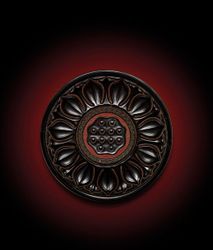TESSIER & SARROU - An Imperial bell under the hammer
Monday 16 December 2019Expert: Cabinet Portier
During the traditional Asian arts week at Drouot, auction house Tessier & Sarrou will present its sale on Monday 16 December. It includes a major work of art: a Chinese Imperial gilt-bronze bianzhong bell from the Qing dynasty (1644-1912). The bell is estimated to reach €200,000 to €300,000. This auction marks the first appearance of this bell on the art market, as is has been kept within the family since Robert de Semallé’s return in France in 1884.
Robert de Semallé (1849-1936) was sent to China to pacify the political tensions between France and China that the “Tonkin Affair” generated. He worked at the Beijing embassy from 1880 and 1884, as illustrated by the photographs he brought back – which sold for €640,000 last June also by Tessier & Sarrou. During his stay in China, Semallé wrote Four years in Beijing, in which he writes about his journeys, his missions in the South of China or the numerous incursions in Tonkin. The works of art he brings back with him to France comprise important pieces, including this stunning bell.
During the traditional Asian arts week at Drouot, auction house Tessier & Sarrou will present its sale on Monday 16 December. It includes a major work of art: a Chinese Imperial gilt-bronze bianzhong bell from the Qing dynasty (1644-1912). The bell is estimated to reach €200,000 to €300,000. This auction marks the first appearance of this bell on the art market, as is has been kept within the family since Robert de Semallé’s return in France in 1884.
Robert de Semallé (1849-1936) was sent to China to pacify the political tensions between France and China that the “Tonkin Affair” generated. He worked at the Beijing embassy from 1880 and 1884, as illustrated by the photographs he brought back – which sold for €640,000 last June also by Tessier & Sarrou. During his stay in China, Semallé wrote Four years in Beijing, in which he writes about his journeys, his missions in the South of China or the numerous incursions in Tonkin. The works of art he brings back with him to France comprise important pieces, including this stunning bell.

A Kangxi (1662-1722) gilt-bronze bianzhong bell
H. 21 cm ; Weight : 4,7 kg
Estimate: €200,000-300,000
This Imperial bell, called bianzhong is, in many ways, exceptional. The magnificent and highly detailed chiseling of the bell speaks for itself: this bianzhong is truly a superb example of Kangxi refinement. A two-faced dragon stands on top of the bell, its muscular body firmly standing on clawed legs, used to hang the bell from the wooden frame. The body of the bell is divided in three registers: the upper one holds a pattern of stylized clouds, so does the lower one, with added perfectly round medallions, where the bell is hit to produce the sound. In between, the dragon’s bodies chasing the pearl among swirls of clouds unfurls, revealing glistening scales chiseled to perfection.
Bianzhong bells are grouped as carillons. Each carillon includes 16 bells: 12 notes and 4 flat tones. There were carillons of small bianzhong, measuring 15-centimeter-high, used for indoor ceremonies, carillons of large bianzhong measuring 30-centimeter-high, used for outdoor ceremonies, mainly military celebrations and carillons of medium bianzhong measuring 21-centimeter-high, for which the use has not yet been revealed. The latter are extremely rare as only two complete sets of medium bianzhong are to be found in the Forbidden City Museum in Beijing.
Not only the 16 December bell is from the rarest ensemble of bianzhongs, but it also generates the most important tone. One of the inscriptions on the bell reads huangzhong: it corresponds to the first note of the scale, and is the yang note, male and powerful. From huangzhong stems the Chinese scale and harmony, but also music itself. Huangzhong is considered as a founding principle of music, a note played at the beginning of each ritual in order to attract good fortune and blessings.
Finally, the other inscription, Kang Xi Bing Shen Nian Zhi chiseled on one side corresponds to 1716. It reveals that the bell was made shortly after Kangxi’s decision to set a new formal musical scale. It marks the exact moment when imperial workshops where at their peak: they made refined new instruments for the Imperial court in order to promote the new Chinese musical scale.

